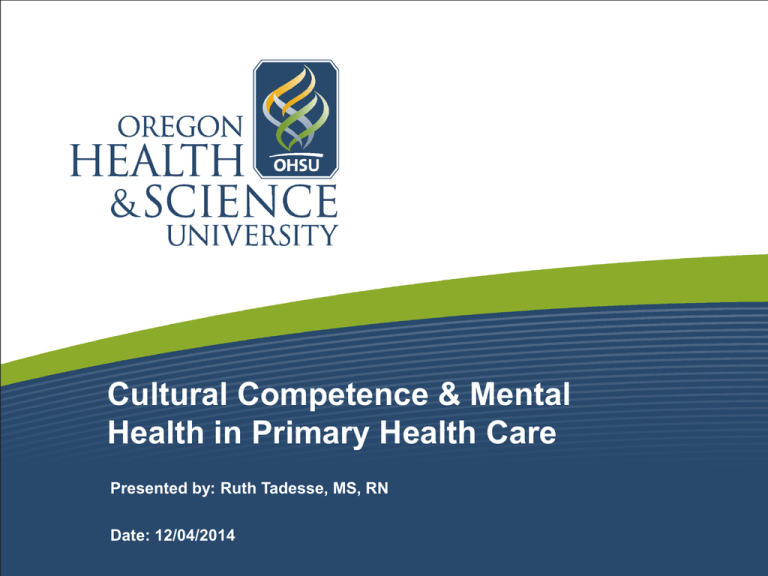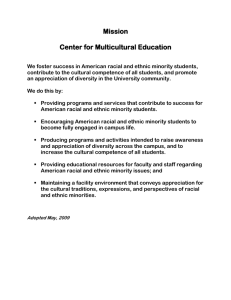Cultural Competence & Mental Health in Primary Health Care Date: 12/04/2014
advertisement

Cultural Competence & Mental Health in Primary Health Care Presented by: Ruth Tadesse, MS, RN Date: 12/04/2014 Disclosures and Learning Objectives • Learning objectives: • Explain the use of 2 cultural assessment tools • Discuss culturally competent interventions that can be used when providing mental health care in primary care setting • Identify 5 cultural competence clinical guidelines Disclosures: Ruth Tadesse has nothing to disclose. What does culture got to do with it? • Review DSM V cultural formulation • Review IOM reports on mental health and addictive disorders • Discuss different cultural assessment tools and interventions • Next week topic What is the right term to use? • Cultural knowledge • Cultural sensitivity • Cultural awareness • Cultural tolerance • Cultural acceptance • Cultural encounter • Cultural competence Cultural Competence Defined “To be culturally competent doesn’t mean you are an authority in the values and beliefs of every culture. What it means is that you hold a deep respect for cultural differences and are eager to learn, and willing to accept, that there are many ways of viewing the world.” Okokon O. Udo, PhD http://xculture.org/cultural-competency-programs/about-cultural-competency/ “Every encounter is a cross-cultural encounter.” Robert C. Like, MD, MS http://rwjms.umd`nj.edu/departments_institutes/family_medicine/chfcd/index.html • Are we similar or are we different? Or could we just be walking in different shoes and gaining different life experiences? Assessment tool: Cultural Formulation Interview (CFI) • CFI -16 questions to ask the individual patient • Informant Version – 17 questions to ask families/caregivers • Supplementary Modules – comprehensive questions including, age specific questions, spirituality & religion, immigrants & refuges http://www.psychiatry.org/practice/dsm/dsm5/online-assessment-measures#Cultural CFI located in DSM-5 IOM Report on Mental Health & Addictive Disorders: The Six Aims of High-Quality Health Care • Safe - Avoiding injuries • Effective – Avoiding underuse and overuse • Patient-centered – Individual patient preferences • Timely— reducing waits and sometimes harmful delays • Efficient—avoiding waste • Equitable— providing care that does not vary in quality http://www.ncbi.nlm.nih.gov/books/NBK19817/ Why should we care about culture? • Racial and ethnic minorities comprise 26% of the total population of the United States. 2010 2000 1990 • In Oregon: White 78 % 83% 91% Latino 12% 8% 4% African American 2% 2% 2% Asian 4% 3% 2% Native American 2.1% 2% 1% Multiracial 2.8% 2.4% ND Other 0.1% 0.1% 0.1% http://quickfacts.census.gov/qfd/states/41000.html Cultural Differences in Mental Health • Racial minorities are more likely to report depressive symptoms to PCPs than to mental health specialists (Snowden, 2001). • Racial, ethnic and cultural minority fear the negative consequences of mental health care (Inerian, et al , 2013). • Mental health plays a major role in physical health and vice versa (Kessler et al, 2005; Mauer, 2003; Lando et al, 2006). Cultural Differences in Mental Health • As many as 70% of issues in primary care setting stem from psychosocial issues (Robinson & Reiter, 2007). • To provide optimal care for a psychiatric patient, modes of treatment has to be individualized (Holden et al, 2014). • Minority patients are among those at greatest risk of non-detection of mental disorders in primary care (Holden et al, 2014). Ideals of Mental Health Dimensions of Cultural Difference EASTERN’ ‘WESTERN’ • Harmony with other people (other valued) • self sufficiency & selfesteem valued • Relationships • Personal autonomy • Balance (‘ecological’) • Efficiency (‘machine like’) • Keep outer world constant (conform with • Keep inner world constant (control altered society) • Freedom of inner experience (variety of inner experience) www.sumanfernando.com states of consciousness) • Freedom of expression (variety in behavior) Cultural Competence Clinical Guidelines in Mental Health • Explore the meaning of • Recognize that mental the aberrant behavior health disorders are from the client’s point complex and are of view influenced by culture • Avoid projection of the • Be aware of self clinician’s worldview cultural competence on the client to avoid influences of • Be aware of the the therapeutic cultural context of relationship help-seeking behavior Group therapy in other cultures Assess using BATHE Method – ~1 minute Lieberman, J. A. & Stuart, M. R. (1999) Background Affect “What is going on with your life? Tell me what has been happening since I saw you last?” “How do you feel about what is going on?” Troubles “What troubles you about this?” Handling of the current situation “How are you handling that?” Empathic response “Sounds like things are difficult for you.” “Let’s schedule you to see one of our behavioral staff.” Intervention: CRASH Course (Rust et al., 2006) Each person is the world expert of their own condition. • • • • • Considering culture Showing Respect Assessing/Affirming differences Showing sensitivities/self-awareness Do it all with Humility What is the danger of not considering culture of the patient? To be continued… Next Week's Topic: Psychopharmacology with Dr. Betlinski or Dr. Hamer The human mind is like an umbrella. It functions best when it is open. –Max Gropius References Center for Healthy Families and Cultural Diversity Department of Family Medicine/UMDNJ -Robert Wood Johnson Medical School www2.umdnj.edu/fmedweb/chfcd/INDEX.HTM Cross Cultural Health Care www.xculture.org CultureMed www.sunyit.edu/library/html/culturemed/ Culturally and Linguistically Appropriate Services (CLAS) United States Department of Health and Human Services Office of Minority Health www.omhrc.gov/clas Diversity in Medicine www.amsa.org/div Ethnomed http://healthlinks.washington.edu/clinical/ethnomed Holden, K., McGregor, B., Thandi, P., Fresh, E., Sheats, K., Belton, A., Mattox, G., & Satcher, D. (2014). Toward Culturally Centered Integrative Care for Addressing Mental Health Disparities Among Ethnic Minorities. Psychological Services. 11(4). pg. 357-368. Ideals of Mental Health Dimensions of Cultural Difference www.sumanfernando.com Initiative to Eliminate Racial & Ethnic Disparities in Health http://raceandhealth.hhs.gov Institute of Medicine (2005). Improving the quality of health care for mental and substance-use conditions: Quality Chasm Series. Washington, DC: National Academies Press. Institute of Medicine (2001). Unequal Treatment: What Healthcare Providers need to Know About Racial and Ethnic Health Disparities. Quality Chasm Series. Washington, DC: National Academies Press. References Initiative to Eliminate Racial & Ethnic Disparities in Health http://raceandhealth.hhs.gov Lieberman, J.A., & Stuart, M. R. (1999). The Bathe Model: Incorporating Counseling and Psychotherapy Into the Everyday Management of Patients. Primary Care Companion Journal of Clinical Psychiatry 1(2): pg. 3539. Mental Health: Culture, Race, and Ethnicity: A Supplement to Mental Health: A Report of the Surgeon General. http://www.ncbi.nlm.nih.gov/books/NBK44246/ National Center For Cultural Competence (NCCC) www.georgetown.edu/research/gucdc/nccc/ “Race” and Culture Issues in Mental Health and Thought Identity http://webcache.googleusercontent.com/search?q=cache:NhVH6TEqdIAJ:www.oise.utoronto.ca/cdcp/Us erFiles/File/Conferences%26Seminars/Conference%2 Resources for Cross-Cultural Health Care www.diversityrx.org Rust, G., Kondwani, K., Martinez, R., Dansie, R., Wong, W., Fry-Johnson Y., & Strothers, H. (2006). A CRASHCourse in cultural competence. Ethnicity & Disease, 16(2, Suppl.3), S3-29-36. Searight, H., R., (2009). Realistic Approaches to Counseling in the Office Setting. American Family Physician. 79(4): pg 277-289. Transcultural and Multicultural Health Links http://web.nmsu.edu/~ebosman/trannurs/index.shtml





